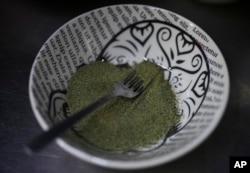A small number of farmers near Lake Texcoco, Mexico, fear that a tradition dating back to the Aztec Empire may disappear.
The tradition involves collecting and eating the eggs of an insect known as the “bird fly.”
The bug, which only occasionally appears before going again under the water, would not look like food to most. But it was once important to the people of the Valley of Mexico.
For Juan Hernández, a farmer from San Cristóbal Nezquipayac, cultivating and collecting the tiny insect eggs known as “ahuautle” or “Mexican caviar” is a way of life.
“For me, more than anything, it means tradition,” said the 59-year-old Hernández. He is one of only six people known to still harvest ahuautle, at least in the Texcoco area. They fear they may be the last people that harvest it.
Jorge Ocampo is a historian at the Center for Economic, Social and Technological Research on Agribusiness and World Agriculture in Mexico State. Ocampo suggested three main reasons for the decreased “Mexican caviar” collection: Lake Texcoco is drying out; the lake area is being developed; and young people are not familiar with the dish.
Ocampo called the dish’s survival an example of “community resistance,” similar to how people around Lake Texcoco have been able to keep other traditions, festivals and ceremonies.
For Hernández, it is hard, dirty work that few are willing to do anymore. While Hernández takes care of collecting the eggs, restaurant owner Gustavo Guerrero serves them to customers at his eatery in Iztapalapa.
One of Guerrero’s favorite dishes is to mix the ahuautle with breadcrumbs and then add eggs. He then fries and serves the mixture with green tomatillo sauce, nopal cactus and squash flowers — all pre-Hispanic ingredients.
“Eating this is like revisiting the past,” said Guerrero, 61. He says the flavor of the ahuautle reminds him of his childhood, when his mother cooked the dish according to a recipe that she learned from her grandmother.
Insects and their eggs have been a part of Mexican cooking for hundreds or thousands of years. Edday Farfán of Mexico’s National Autonomous University said there are more than 430 kinds of edible insects in Mexico.
Farfán has been studying bird flies since 2016, and even has one tattooed on his arm.
Farfán said indigenous peoples living around the lakes adopted the insect eggs as a source of protein because they had few domestic animals before the Spanish conquest of 1521.
But now, Farfán said, the dish “is associated with the countryside, perhaps with poverty, as if it were an undesirable protein.” Even those still familiar with ahuautle often consider the insects to be food for chickens or turkeys.
“There are a lot of kids, young people who don’t eat it anymore, they don’t like it,” Hernández admits.
“Now we are just keeping ahuautle alive,” he said. “I hope it doesn’t disappear, because it is a source” of “income for those of us who live off the land.”
I’m John Russell.
Fabiola Sanchez reported on this story for the Associated Press. John Russell adapted it for VOA Learning English.
_______________________________________________________________________
Words in This Story
cultivate – v. to grow or raise (something) under conditions that you can control
dish -- n. food that is prepared in a particular way
breadcrumb – n. a very small piece of bread
fry – v. to cook (food) in fat or oil
ingredient -- n. one of the things that are used to make a food, product, etc.
edible – adj. suitable or safe to eat
tattoo -- v. to draw or write (a picture, word, etc.) on a part of someone's body by using a needle and ink
adopt -- v. to begin to use or have (a different manner, method, etc.)
income – n. money that is earned from work, investments, business, etc.












Forum